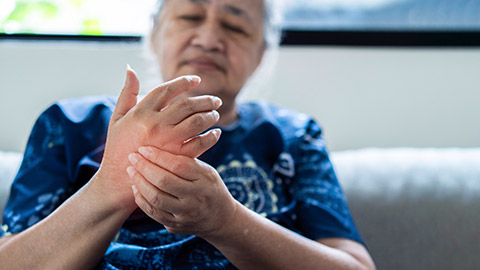Working in aged care means you'll encounter various diseases among the elderly. Understanding and managing these conditions is essential for providing professional care. This involves recognising subtle health changes, applying treatments, and offering both physical and emotional support.
In this section, we'll cover the following points:
- Exploring frequently encountered diseases in aged care.
- Describing the symptoms associated with these diseases.
- Discussing potential lifestyle adjustments.
- Investigating medications and therapies applicable to each condition's treatment.
Activity - Reflection
Before we commence with the module, let's engage in a self-reflective activity. Take a moment to consider and document the kinds of diseases you have come across or anticipate encountering in your workplace within the aged care sector.
Let's explore how gaining an understanding of the appropriate treatment options for common diseases will better prepare you to make a positive impact on the health and well-being of the individuals you care for. The diseases we will be learning about include:
- Hypertension
- Diabetes mellitus (Type 2 diabetes)
- Chronic obstructive pulmonary disease (COPD)
- Osteoarthritis
- Dementia
- Cardiovascular disease chronic kidney disease
- Rheumatoid arthritis
- Stroke
- Parkinson's Disease
Hypertension

Elevated blood pressure, known as hypertension, is a prevalent health issue frequently observed in older adults. As individuals age, the vascular system, which comprises the network of blood vessels in the body, changes. Arteries, in particular, tend to become less flexible, increasing blood pressure. This can be true even for people who have heart-healthy habits and feel just fine. Let's take a look at the symptoms, lifestyle modifications and the most common medications and therapies for treating hypertension.
Learn more about hypertension.
Diabetes mellitus (Type 2 diabetes)
Diabetes is the result of the body not creating enough insulin to keep blood glucose (sugar) levels in the normal range. Everyone needs some glucose in their blood, but if it’s too high it can damage your body over time. Type 2 diabetes is the most common form of diabetes. While type 2 diabetes cannot be cured, it can be managed and people with type 2 diabetes can and do live active and healthy lives.
Learn more about Type 2 Diabetes.
Chronic obstructive pulmonary disease (COPD)
COPD, or Chronic Obstructive Pulmonary Disease, primarily arises from two main conditions, emphysema and chronic bronchitis. The leading cause of COPD is prolonged exposure to substances that irritate and harm the lungs, most notably through smoking. Symptoms include persistent shortness of breath, chronic cough, and the production of phlegm or mucus. People with COPD face an increased risk of chest infections, leading to frequent hospital admissions. Although there is no cure for COPD, several measures can significantly improve symptoms and enhance breathing, such as quitting smoking, adhering to inhaler medications, and staying current with vaccinations.
Watch this video for a clear and simple overview of COPD. You might like to take notes as you watch. After you have viewed the video, answer the questions below.
Activity - Quiz
To understand what it’s like living with COPD watch these personal stories.
Osteoarthritis

Osteoarthritis (pona ngoikore) is the most prevalent form of arthritis, characterised by pain, swelling, and diminished joint mobility. It impacts various components of the joint, including cartilage, joint linings, ligaments, and muscles. Frequently affected joints include those in the hands, fingers, knees, hips, and the spine (both neck and lower back). Implementing lifestyle changes, such as exercise and weight management, in conjunction with other therapies, can enhance mobility, alleviate pain, reduce flare-ups, and hinder the progression of osteoarthritis.
Activity - Scenario
Read the scenario below and answer the questions.
You are a support worker in an aged care facility, and you've been assigned to care for an elderly resident named Margaret, who was recently diagnosed with osteoarthritis. Margaret is in her late 70s and has been experiencing pain, stiffness, and swelling in her knees and hips. She's also mentioned having difficulty with everyday activities like walking, getting out of bed, and even holding utensils due to her joint pain.
Read more information on Osteoarthritis.
Dementia
In module 3, we will delve deeper into the topic of dementia, but for now, let's provide an overview.
Activity - Video & Quiz
Watch this video ‘What is Dementia?’ and answer the questions below.
Although there is no cure for dementia there are treatments including; Cognitive stimulation therapy, reminiscence therapy, and music therapy. Medications like cholinesterase inhibitors or memantine can help manage cognitive symptoms.
Cardiovascular disease
Cardiovascular disease (CVD) is the collective term for diseases of the heart and blood vessels. CVD kills more than one in three New Zealanders and is responsible for more than 30,000 hospital admissions each year.
Men's death rate from CVD is more than twice that of women's. Over 80% of deaths related to CVD occur in people over 65 years.
Activity - Video and Questions
Read more about heart disease and answer the following questions.
Chronic kidney disease
Kidney disease is a condition where the kidneys become damaged, impairing their vital functions of filtering waste and regulating the body's fluids and electrolytes. It can manifest as acute kidney injury or chronic kidney disease, often caused by factors like diabetes, hypertension, infections, or medication toxicity. Symptoms may include fatigue, swelling, changes in urination, and more. As kidney disease progresses, it can lead to serious complications. Treatment options range from medication and lifestyle changes in the early stages, to kidney transplantation in advanced cases.
To learn more about kidney disease in New Zealand watch this video Understanding Kidney Disease on Vimeo and answer the questions below.
Rheumatoid arthritis
Read the following scenario and research the answers to the question. Write down your answers so you can refer back to them later.
Scenario
You are a support worker in an aged care facility, and one of your regular residents, Mrs. Lu, has Rheumatoid Arthritis (RA). Mrs. Lu is a friendly and active 78-year-old woman who enjoys socializing with other residents and participating in group activities. Lately, you've noticed that she has been experiencing more discomfort than usual, joint pain, and stiffness, especially in her hands and knees. She has mentioned these symptoms to you and expressed her concern that it will interfere with her activities. It's important as a support worker to understand Rheumatoid Arthritis so that you can empower residents like Mrs. Lu to manage their condition effectively, improve their daily lives, and ensure they can maintain their independence and well-being for as long as possible.
Stroke
Each year about 9,000 people in New Zealand have a stroke. Strokes are more common as you get older, with 76% of strokes occurring in people over the age of 65 years. As support workers for the elderly, understanding strokes is of paramount importance because your role goes beyond just providing assistance with daily activities. You are often the first responders in recognising the signs of a stroke and ensuring immediate medical attention. By learning about the causes, symptoms, and immediate responses to strokes, you can be the lifeline that ensures your elderly clients receive timely and appropriate care. Also, continuous support in the aftermath of a stroke is vital in helping individuals regain their independence and quality of life. So, let's take some time to understand strokes and how to respond.
Activity - Video and Quiz
Read and learn more about strokes.
Parkinson’s disease
Parkinson’s is a progressive neurodegenerative condition caused by insufficient quantities of dopamine in the brain. Parkinson’s has both motor and non-motor symptoms, and while it cannot be cured it can be treated. Support workers in aged care will assist individuals with Parkinson's disease by providing physical support, medication management, and emotional encouragement to help them maintain the highest possible level of independence and quality of life.
Research the treatments for Parkinson’s and complete the activity below.
Activity - Drop and Drag
Each of the diseases we have looked at presents its own unique set of challenges and requires a specific approach in terms of care and support. By gaining insights into these diseases, you will be better equipped to provide holistic care, support, and empathy to the elderly individuals you work with. Now, take a moment to reflect on your learning and address the following questions:
